Best no-code AI tools 2026 explained: What, how, benefits
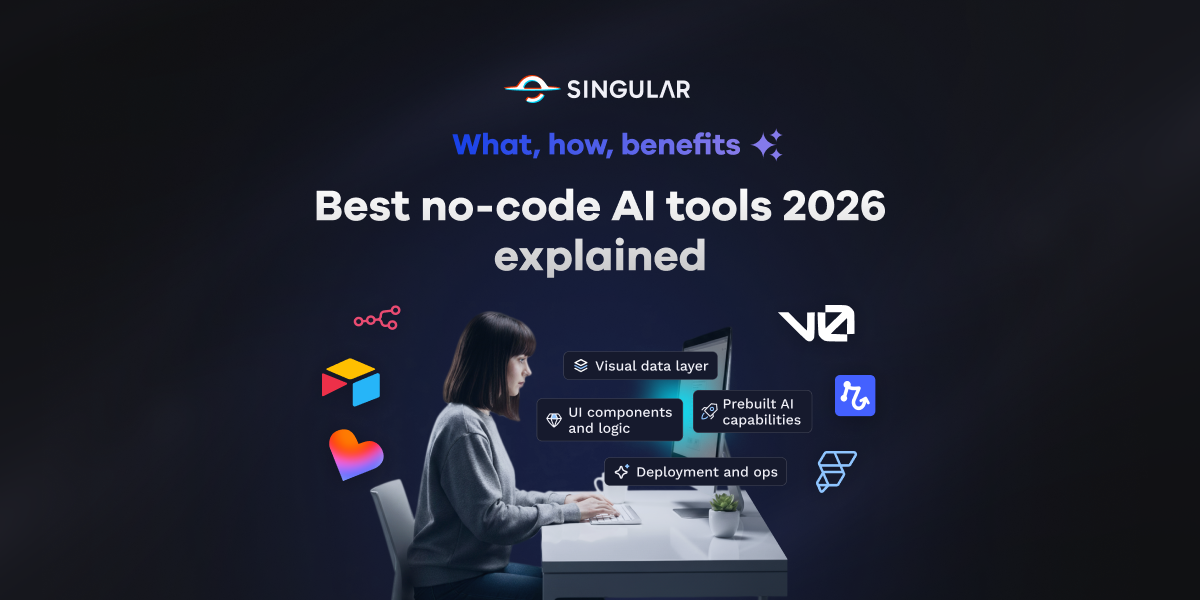
No-code AI has moved from a clever hack to a practical standard. Teams across the US now stand up working apps, agents, and automations in days, not quarters. If you’re choosing the best no-code AI tools 2026 has to offer, the goal isn’t just to ship faster—it’s to give more people the power to build safely, at scale.
Best no-code AI tools 2026 means platforms that let non‑developers design, deploy, and govern AI apps through visual building, templates, and guided workflows while connecting to live business data. Expect drag‑and‑drop UIs, data connectors, prebuilt models, and one‑click deployment with enterprise controls.
Here’s the fast answer you might be looking for: the best no-code AI tools in 2026 help you connect data, pick a task‑fit model, configure outputs, then deploy with monitoring. Choose no-code when speed and accessibility matter, low-code when you need deeper customization or complex integrations at scale.
Book a call to get a tailored shortlist and a 30‑day pilot plan for your team.
What Is No Code AI In 2026?
Core building blocks and components
No‑code AI platforms wrap the hardest parts of AI development—data prep, model selection, orchestration—inside an interface that feels like building with blocks instead of scripts. Typical building blocks include:
- Visual data layer: Bring in Google Sheets, CSVs, databases, or synced sources and define tables, fields, and relationships with clicks instead of SQL. Many tools connect to popular SaaS apps and APIs for live data sync.
- Prebuilt AI capabilities: Classification, NLP, summarization, text generation, and prediction exposed as configurable components. The platform handles preprocessing and training where relevant.
- UI components and logic: Drag‑and‑drop forms, lists, charts, and pages with rule builders for “when X, do Y.” Visual workflows replace code for most app logic.
- Deployment and ops: One‑click publish, hosting, role‑based access, audit logs, and data privacy controls that meet enterprise security expectations.
From a user’s perspective, it feels like designing a spreadsheet-backed app that also thinks for itself. Over the past decade, that ergonomic shift—away from code editors and toward visual orchestration—has pulled AI into everyday business workflows.
Common use cases across teams and companies
- Operations and support: Intake portals, triage, and routing with AI summaries and suggestions; document classification and data extraction; internal knowledge agents that answer grounded questions.
- Marketing and product: Feedback analysis, campaign ideation, content generation with approval steps, audience scoring, and experimentation dashboards.
- Sales and success: Lead qualification, renewal risk prediction, QBR prep with auto‑generated insights and visuals, customer portal self‑service.
- Analytics for everyone: Natural‑language querying of business data, quick predictive models for churn, propensity, or forecast—packaged as safe, reusable apps.
Quick micro‑story: a regional retailer stitched together a simple returns portal in a weekend—Google Sheets for data, a no‑code app builder for the UI, and an AI step that tags reasons and flags edge cases. On Monday morning, the ops lead said, “It’s calmer. We can see what’s happening.” That’s the point.
Limits and tradeoffs to consider
- Customization ceiling: Visual builders move fast, but complex logic, niche data transforms, or unusual UI patterns may push you toward low‑code extensions.
- Vendor boundaries: Pricing often ties to usage units, tasks, or records. Understand data limits, model access, and egress policies up front. Treat it like infrastructure planning.
- Quality and drift: AI features add variability. Good platforms add guardrails—validation, grounding, and monitoring—but outputs still need review in sensitive workflows.
- Governance posture: Democratizing building should come with role‑based permissions, audit trails, and clear data residency and retention standards.
No Code vs Low Code: What To Use When
Key differences in users and skills
No‑code favors domain experts who think in workflows and outcomes. Low‑code favors technical builders who want both speed and fine control. The practical difference shows up when you hit an edge case: no‑code steers you toward a visual pattern or template; low‑code lets you drop into custom logic when needed.
When no code fits best
- Time‑to‑value beats perfect fit: Prototypes, pilot apps, short‑cycle automations.
- Citizen development with oversight: Teams can build safely within guardrails and share outcomes quickly.
- Standard patterns: CRUD apps, forms, portals, dashboards, AI‑assisted analysis, and content workflows match common templates well.
When low code fits best
- Complex integrations or performance needs: Real‑time events, heavy data shaping, or bespoke front‑ends.
- Extensibility mandates: You anticipate unique logic, custom APIs, or component reuse across products.
- Strict cost control: If usage‑metered pricing clashes with scale, owning more of the stack can make sense, with the tradeoff of higher engineering overhead.
How No Code AI Tools Work: Step By Step
Connect data sources like Google Sheets
Most journeys start by connecting the system of record. Platforms typically support Google Sheets, CSV uploads, native tables, and connectors for CRMs or data warehouses. You map fields, set relationships, and define who can view or edit each table. The platform creates the scaffolding for forms and pages automatically.
Choose a model and configure outputs
Next comes the “intelligence” block. For predictions, you’ll see task‑specific starters such as classification or regression. For language tasks, you’ll configure summarization, extraction, or generation—often with prompt templates, system instructions, and guardrails. The platform handles preprocessing, training or fine‑tuning when applicable, and evaluation behind the scenes.
Good practice is to pair model outputs with validation rules and human‑in‑the‑loop steps for sensitive decisions. Clear instructions, grounded context, and post‑processing reduce variance in outputs.
Deploy, monitor, and iterate safely
Publishing is usually a single click, but the real work is in observability. Track usage, outcomes, failure rates, and data quality. Many tools include role‑based access, audit logs, and controls for PII handling, with options for US data residency and enterprise compliance. The cycle becomes: ship a version, watch behavior, tighten prompts or thresholds, and scale out.
Benefits Of No Code AI For US Businesses
Faster time to value
Market signals point to durable growth for no‑code AI in the US, with expansion powered by demand for rapid prototyping and democratized development. Speed is the headline benefit. Teams move from problem statement to working app in days, validating with real data and users instead of slideware.
Lower cost and fewer dependencies
Shifting common app patterns and AI features to visual builders reduces the load on scarce engineering capacity. That doesn’t remove the need for developers; it lets technical staff focus on hard problems while business teams solve local ones within guardrails. Budgets stretch further when pilot projects avoid protracted custom builds.
Governance, security, and compliance basics
Modern platforms foreground security: SSO, RBAC, granular permissions, logging, and clear data processing policies. Enterprise‑ready offerings add SOC 2, HIPAA, ISO controls, model execution within the vendor’s US cloud, and no data retention for training by default. That baseline matters when AI features touch customer data.
Evaluation Criteria For The 2026 Top Picks
Ease of use for beginners and pros
- Learning curve: Can non‑technical builders ship something real in a week.
- Editor quality: Clear UI, good defaults, inline help, and promptable generation that creates a strong starting point.
- Community and guidance: Templates, tutorials, and examples shorten the path to value.
Integrations, data, and API support
- Connectors: Sheets, SQL, major CRMs, and webhooks at minimum.
- APIs and actions: Ability to call external services or expose your app’s endpoints for automation platforms like Zapier or Make.
- Model access: Clear support for task‑fit AI models or bring‑your‑own, with configuration transparency.
Scalability, pricing, and limits
- Data scale: How many records, files, and users can you support without a rewrite.
- Usage economics: Understand how tasks, workloads, or agent runs map to bills.
- Governance at scale: Environments, roles, audit trails, and provisioning for larger teams.
Top 10 No Code AI Tools 2026 Editor Picks
Airtable
Airtable is an AI-native app platform that transforms everyday data into dynamic interfaces, automated workflows, and intelligent agents - all built without code.
Through Omni, its conversational AI builder, teams can describe what they need in plain language and instantly generate custom applications tailored to their operations.
Across departments, Airtable’s intelligent agents can act on large datasets, automate decisions, and coordinate complex actions turning routine processes into self-running systems.
Its architecture is built for both speed and scale, supporting hundreds of millions of records while maintaining enterprise-level governance and performance.
Airtable integrates leading AI models including OpenAI, Gemini, Llama, and Anthropic, allowing teams to choose the right engine for each task. Security, compliance, and regional data control come standard, giving organizations the confidence to scale safely.
With native API connections to tools like Slack, Salesforce, Google Workspace, and Notion, Airtable keeps your workflows connected and your data synchronized across every part of the business.
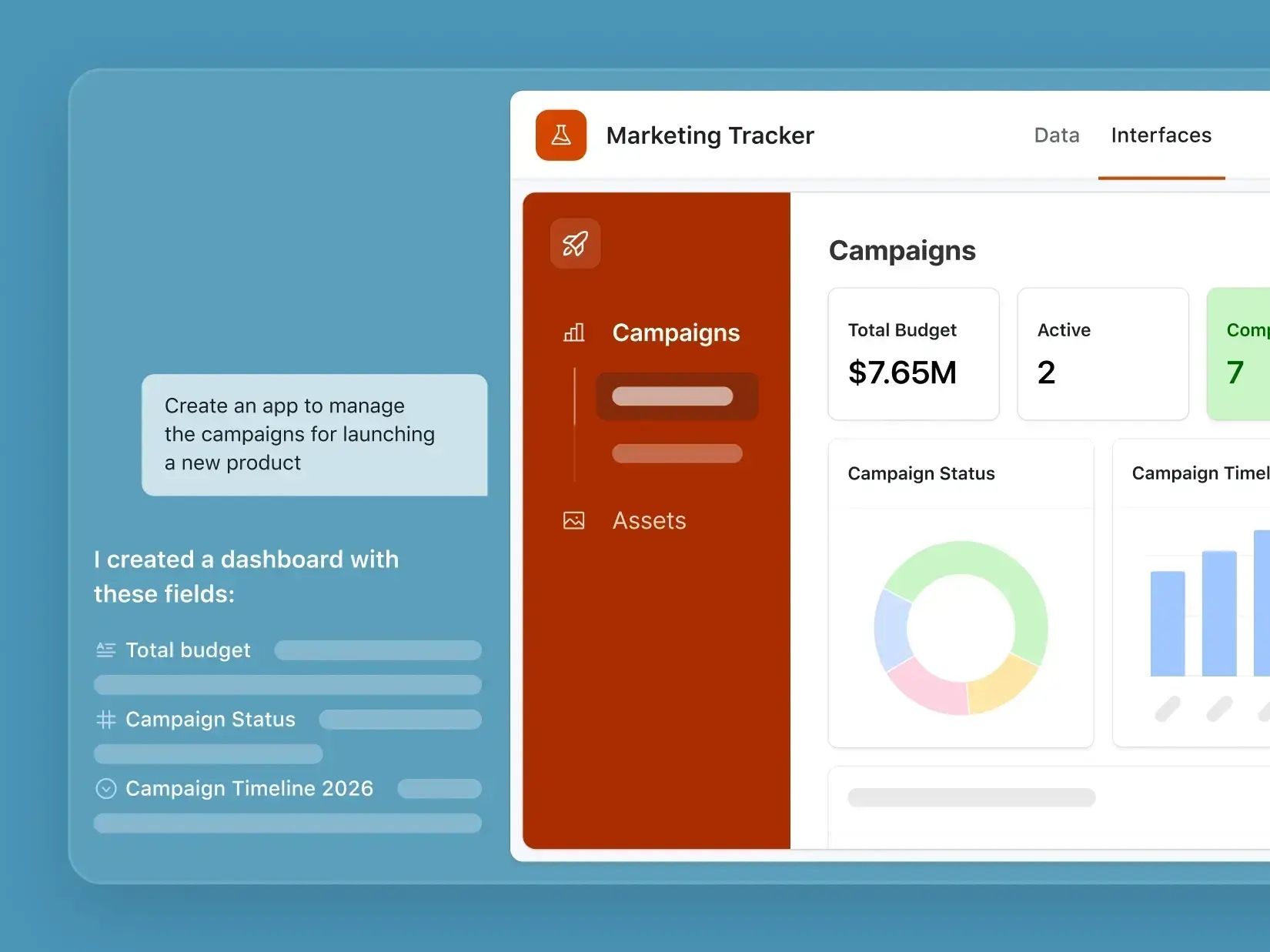
Pros
- Conversational AI building with Omni that turns natural language into functioning applications.
- Dynamic AI agents that reason, automate, and act across complex datasets.
- Enterprise-grade security and compliance (SOC 2 Type II, GDPR, SSO, and data residency options).
- Scalable architecture capable of handling millions of records and multi-team access.
- Extensive integrations with popular tools and APIs.
Cons
- Advanced automation and agent orchestration features require higher-tier plans.
- Learning curve for new users managing complex relational data.
- Some advanced AI capabilities (like fine-tuned model integrations) still rolling out gradually.
Why it stands out & Best for
Airtable uniquely bridges the gap between approachability and enterprise scale — something few no-code platforms achieve.
It enables teams to move from static databases to living, intelligent applications that evolve with business needs.
Best for:
Cross-functional teams that need a single source of truth — uniting data, automations, and AI agents under one governed and scalable platform. Ideal for operations, marketing, product, and enterprise innovation teams.
Pricing
- Free plan: Airtable’s free tier is ideal for small teams or individuals getting started with no-code app building. It includes 500 AI credits per editor each month, unlimited bases, and up to 1,000 records per base. You can add up to five editors and run up to 100 automations — enough to build and test early workflows without commitment.
- Team plan ($20 per user/month, billed annually | $24 monthly): Designed for collaborative teams, this plan unlocks 15,000 AI credits per paid user each month, along with 50,000 records per base and 25,000 automation runs. It also introduces sync integrations, Gantt and timeline views, and extensions to customize how your data and automations connect.
- Business plan ($45 per user/month, billed annually | $54 monthly): Built for larger teams or departments, this tier raises limits significantly — 20,000 AI credits, 125,000 records per base, and 100,000 automation runs. It adds two-way sync, verified data, an admin panel, and SAML-based SSO, making it a good fit for organizations that need governance, collaboration, and performance at scale.
- Enterprise Scale plan (custom pricing): For organizations managing data-heavy operations or strict compliance needs, Enterprise includes 25,000 AI credits per user, 500,000 records per base, and 500,000 automation runs. It adds advanced tools such as HyperDB, Enterprise Hub, and API-level access with audit logs and DLP (data loss prevention).
Partner note: Singular Innovation is an Airtable Service Partner.
Vercel
Vercel is a modern frontend cloud platform designed to make deploying, scaling, and managing web applications seamless. It handles the infrastructure behind your user-facing logic and interfaces so teams can focus on building. Nnot devops.
It supports popular web frameworks (like Next.js, React, Astro, Svelte, Nuxt) and integrates serverless functions, edge middleware, and global CDN by default.
When you push code, Vercel autodeploys it, spins up preview environments, and serves your site from the edge, all with zero configuration required

Pros
- Instant deployment & previews: Each commit triggers a new preview, giving real-time feedback.
- Edge + serverless support: Run logic, APIs, or middleware close to your users. Vercel+1
- Zero-config scaling: Infrastructure scales automatically as demand grows.
- Framework support + optimizations: Built-in optimizations for Next.js and other modern frameworks. CodeWalnut+2Vercel+2
- Integrated analytics & monitoring: Performance insights, logging, and metrics included.
Cons
- Pricing can jump significantly when usage exceeds included limits (bandwidth, compute, function usage).
- Edge or serverless features sometimes require careful tuning to avoid cold starts or over-billing.
- Enterprise features (SSO, custom domains, audit logs) are locked behind higher tiers or custom contracts.
Why it stands out & Best for
Vercel is unique in that it abstracts away the complexity of infrastructure while optimizing for developer experience and performance. It’s not trying to be a full backend platform — instead, it focuses on making frontend and edge logic deployment frictionless.
Best for:
- Teams building web apps, frontends, dashboards, or AI-powered interfaces who want fast, scalable delivery without infrastructure overhead.
- Projects where performance (latency, caching, rendering speed) and deployment velocity matter.
- Use cases combining UI + lightweight server logic (APIs, edge functions) rather than heavy data or database layers.
Pricing
- Hobby (Free): Ideal for personal projects or proof-of-concepts. Includes edge CDN, basic functions, 360 GB-hr memory, 4 CPU-hrs, 100k Edge Config reads, and default limits.
- Pro ($20 / seat / month): Adds more resource quotas, team collaboration features, higher throughput for serverless functions and bandwidth, and advanced build performance.
- Add-ons: SAML Single Sign-On ($300/month), HIPAA BAA ($350/month), observability modules, analytics, flags explorer, etc. Vercel
- Enterprise (Custom Pricing): For organizations needing strict SLAs, audit logs, multi-region failover, custom domains, security features, and dedicated support. Community reports suggest pricing often starts in the high five- or six-figure annual range.
Partner note: Singular Innovation is a Vercel Solution Partner.
Lovable
Lovable is an AI-first app builder that converts natural language prompts into full-stack web applications - no manual coding required. Users describe their app concept, and Lovable generates frontend, backend, and database logic automatically. It supports deployment and versioning, letting teams iterate quickly without worrying about infrastructure.
Through a credit/message system, Lovable manages how much AI assistance you can use per month. It builds on integrations like Supabase and GitHub, giving each project ownership of the generated code and the flexibility to extend it later.
The goal: make app development as simple as a conversation, while still delivering real production assets.

Pros
- Rapid prototyping: Turn ideas into working apps in minutes.
- Code export & ownership: Projects link to GitHub so you retain full code control.
- Backend integration: Native support for Supabase (authentication, data, real-time) and storage.
- Scalable for teams: Collaboration, roles, and permissions available on paid plans.
- Custom domains & privacy: Paid tiers allow branding and private projects.
Cons
- Usage is constrained by credit/message limits; complex apps can exhaust them quickly.
- Advanced features like SSO, enterprise governance, or custom integrations require higher tiers or custom quotes.
- For non-trivial apps, you may need to refine or optimize the generated code manually.
Why it stands out & Best for
Lovable shines as a “vibe coding” tool, enabling non-technical teams to meaningfully participate in development while giving developers a fast start. It bridges idea to prototype to production, letting hybrid teams iterate on logic through prompts.
Best for:
Early-stage startups, product teams, or innovators who want to prototype fast without losing control of code. Also good for internal tools or experimental apps where speed matters more than deep customization off the bat.
Pricing
(As of latest public info)
- Free plan: Basic access with limited daily credits, public projects only.
- Pro (~US$25/month): Includes 100 credits/month, private projects, custom domains, and role permissions.
- Business (~US$50/month): Adds team controls, collaboration, and more flexibility.
- Enterprise (Custom): For large organizations needing dedicated support, custom integrations, and higher limits.
Bubble
Bubble is one of the most powerful no-code app builders on the market right now. A true full-stack platform that lets you design, build, and scale web applications visually. It combines the freedom of traditional coding with the accessibility of drag-and-drop design.
At its core, Bubble has a visual programming language that feels intuitive even to beginners. You can create complex logic, define data models, and craft beautiful interfaces, all without touching a single line of code. The designing UI elements is like working in Canva, while structuring data resembles working in Excel so it's friendly for anyone to get started with.
Workflows in Bubble operate much like automations in Zapier in which allows you to define actions, triggers, and conditions step-by-step to make your app behave exactly how you want. Its expression composer is particularly impressive. It's a guided system of dropdowns that lets you write logical expressions and dynamic formulas that would otherwise require custom code.
Recently, Bubble introduced AI-assisted app generation. You can describe what you want to build “a client booking app,” “a team dashboard,” “a community marketplace” and Bubble’s AI will generate a starting point complete with UI, data schema, and logic that you can refine. You can also connect to external AI services like OpenAI through the API connector, bringing intelligent features like chatbots, recommendations, or data analysis into your app.
In short, Bubble gives you the creative freedom of a developer with the speed of a no-code tool and the ecosystem, community, and documentation to back it up.
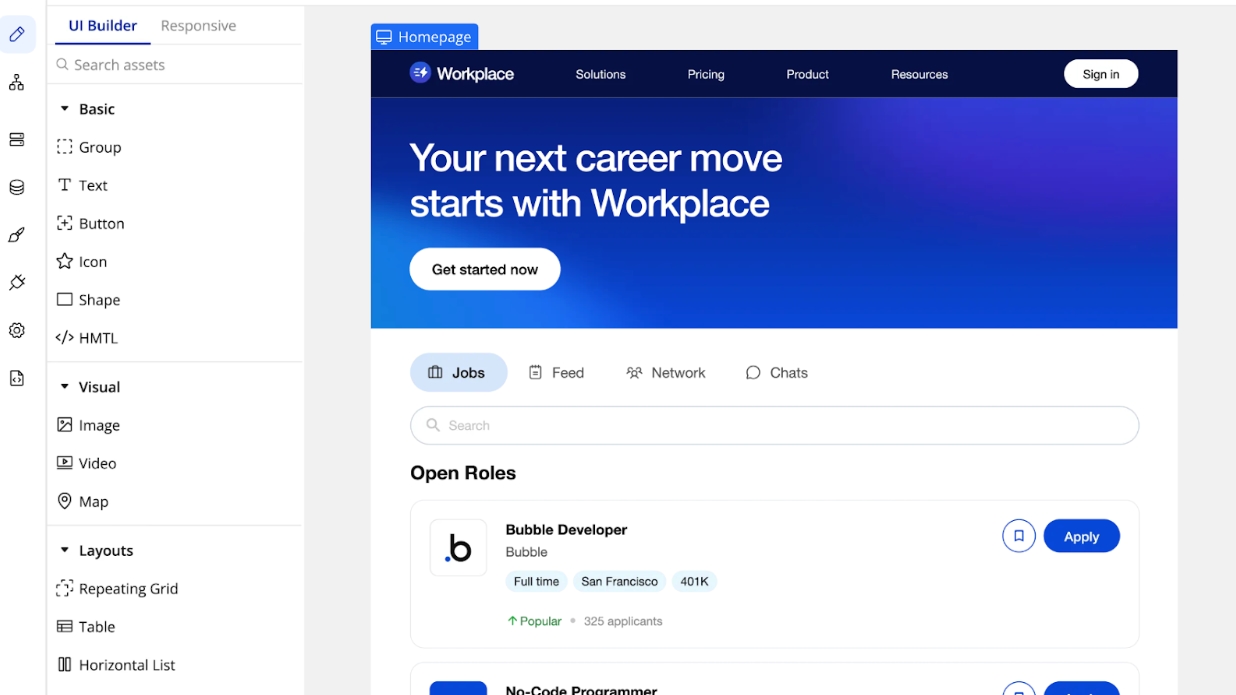
Pros
- True full-stack flexibility: Build complete web apps, from frontend to database to backend logic.
- Powerful workflows: Advanced logic and conditionals that rival low-code or traditional coding environments.
- AI-assisted generation: Quickly spin up new pages or apps from natural language prompts.
- Huge plugin marketplace: 1,000+ community-built extensions and integrations.
- Responsive editor & mobile builder: Create web and native apps from one platform.
- Vibrant community + learning resources: Tutorials, templates, and an active marketplace of experts.
Cons
- Steeper learning curve: Beginners will need time to master workflows, database structure, and performance optimization.
- Performance tuning required: Apps can feel heavy if not optimized (e.g., large datasets, excessive conditionals).
- Limited native AI tools: Requires API integrations for advanced AI use cases.
- Pricing complexity: Costs can increase as app traffic or workload scales.
Why it stands out & Best for
Bubble stands out for one simple reason — it’s as close to coding as no-code gets. Unlike simpler page builders, Bubble gives you granular control over everything: logic, data, user permissions, and performance. That’s why many professional no-code agencies use Bubble exclusively for client projects.
Best for:
- Entrepreneurs building SaaS platforms or marketplaces
- Startups needing quick MVPs that can scale
- Internal tool creators who want deep customization
- Teams experimenting with AI features without a backend team
Pricing
- Free: Great for testing ideas, experimenting with workflows, and learning the platform. Includes limited capacity and branding.
- Starter ($29/month): Adds custom domains, higher storage limits, and more workflows — suitable for personal projects or prototypes.
- Growth ($119/month): Designed for serious builders. Includes higher app capacity, collaboration tools, API access, and professional support.
- Team ($349/month): Adds advanced version control, role-based permissions, and scalability for production-grade apps.
- Enterprise (Custom): Includes dedicated infrastructure, advanced security (SSO, SOC2), and white-glove support for organizations with compliance needs
Flutterflow, Firebase, and BuildShip
FlutterFlow is a visual app builder built on Google’s Flutter framework, designed for teams that want to create production-grade mobile and web applications without diving into traditional code.
It combines the visual simplicity of drag-and-drop design with the power of native performance. In FlutterFlow, you’re not just placing UI elements — you’re designing pixel-perfect, cross-platform experiences that can run on iOS, Android, and web with a single build.
The editor feels fluid and modern. You can connect screens, build workflows, and even preview real smartphone interactions directly in your browser. The app’s component library is vast — progress bars, carousels, gestures, animation triggers, payments, authentication, and even AI integrations — giving you all the building blocks you need to move from idea to MVP fast.
Under the hood, FlutterFlow connects seamlessly with Firebase, handling user authentication, databases, and cloud functions. The setup is clean and well-documented, and the data syncs instantly between app and backend. If you prefer SQL-style data modeling, it also supports Supabase as a relational alternative.
For more advanced users, the platform allows full custom code blocks, so developers can inject Dart or REST logic without leaving the visual builder. It’s the sweet spot between no-code and low-code and a favorite among teams scaling from prototype to production.
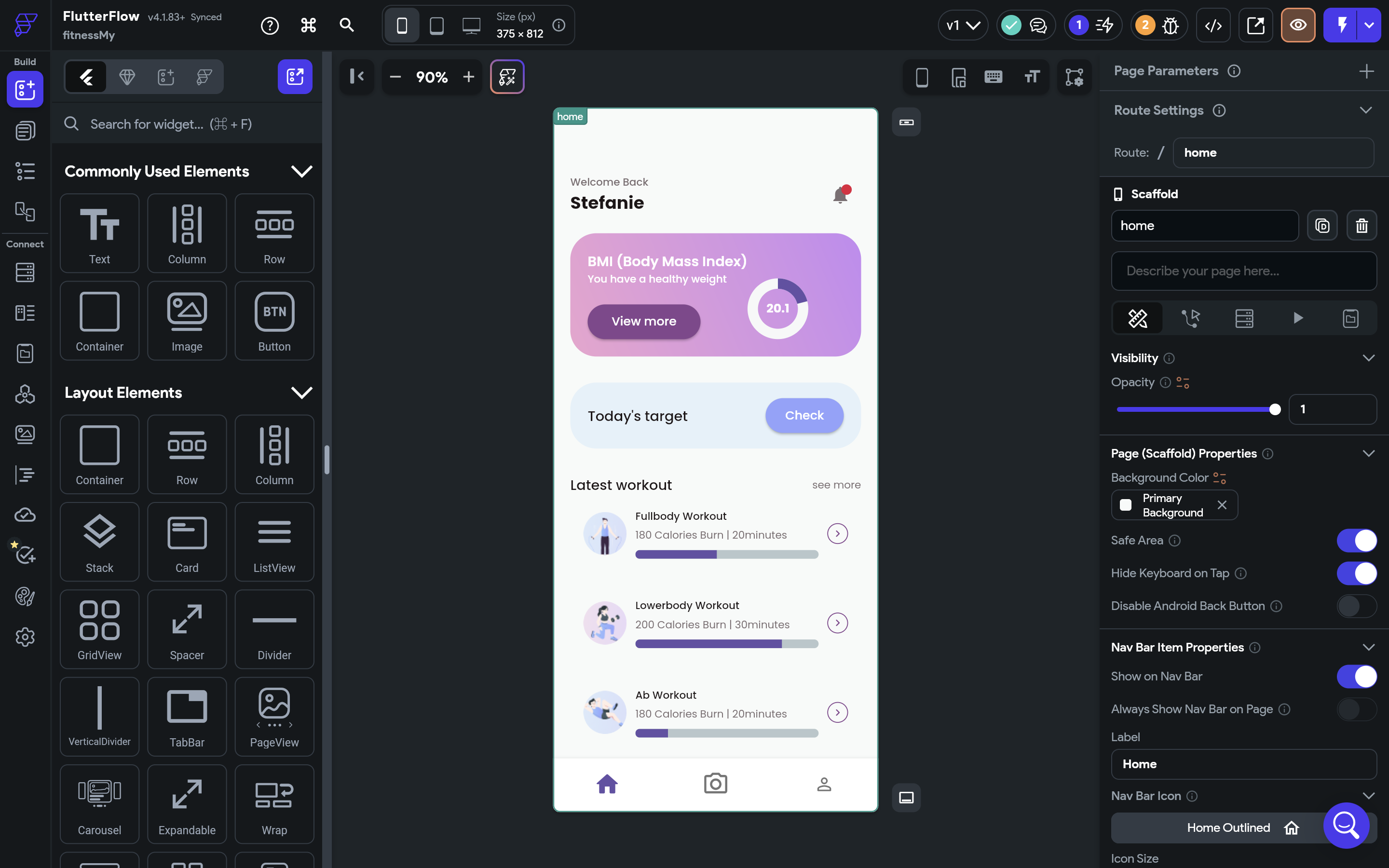
Pros
- Native performance: Apps built in FlutterFlow run natively across Android, iOS, and web.
- Full Firebase integration: Authentication, Firestore, Cloud Functions, and analytics ready to go.
- Custom code support: Add Dart code or API calls without breaking the visual flow.
- Intuitive UI builder: Drag, connect, and animate — all visually.
- Team collaboration: Version control, branching, and roles built-in.
- AI features: Generate UI layouts and data models from natural language prompts.
Cons
- The learning curve can feel steep if you’re new to app data architecture or backend concepts.
- Firebase’s NoSQL structure may frustrate users used to relational databases.
- Complex animations or heavy logic can affect build performance.
- Some enterprise-grade features (SSO, deployment automation, audit logs) require higher-tier plans.
Why it stands out & Best for
FlutterFlow stands out as the bridge between no-code convenience and real developer control. It gives non-technical founders and designers the power to build beautiful, production-ready apps — but still satisfies experienced developers who want to go deeper with custom code and integrations.
Best for:
- Startups launching mobile-first products or SaaS MVPs
- Teams building AI-driven customer apps or dashboards
- Developers who want a visual environment without losing code-level flexibility
- Agencies or internal innovation labs working on cross-platform experiences
Pricing
- Free: Explore the builder, experiment with UI, and export small prototypes.
- Standard ($30/month): Includes app previews, Firebase integration, and limited custom actions. Great for solo founders or early-stage projects.
- Pro ($70/month): Adds full API access, custom functions, advanced animations, GitHub sync, and app export for publishing to iOS and Android stores.
- Teams ($200/month): Enables collaboration, shared projects, and role management.
- Enterprise (Custom): Designed for organizations that need security, compliance, and custom deployment pipelines.
Softr
Softr is a no-code app builder that turns Airtable or Google Sheets data into fully functional web apps, internal tools, and client portals — all in minutes. It’s one of the most intuitive platforms in the space, giving non-technical teams the power to build polished, data-driven experiences without ever touching code.
Think of it as the “Squarespace for databases.” You connect your data source, choose from pre-built templates, and drag components like tables, forms, or charts onto the page. In minutes, you have a dynamic app that updates automatically when your data does. Softr also includes granular permission controls, allowing you to decide exactly who sees what — perfect for creating customer dashboards, partner portals, or internal tools where data security matters.
Recently, Softr has expanded into AI workflows, letting you enrich, summarize, or categorize your Airtable data using AI directly within the interface. Whether you’re building a recruitment dashboard that ranks candidates, a CRM that summarizes deals, or a community directory with search and filters — Softr can handle it all.
It strikes a sweet balance between ease of use and real business utility — ideal for teams that need structure, but don’t want to maintain infrastructure.
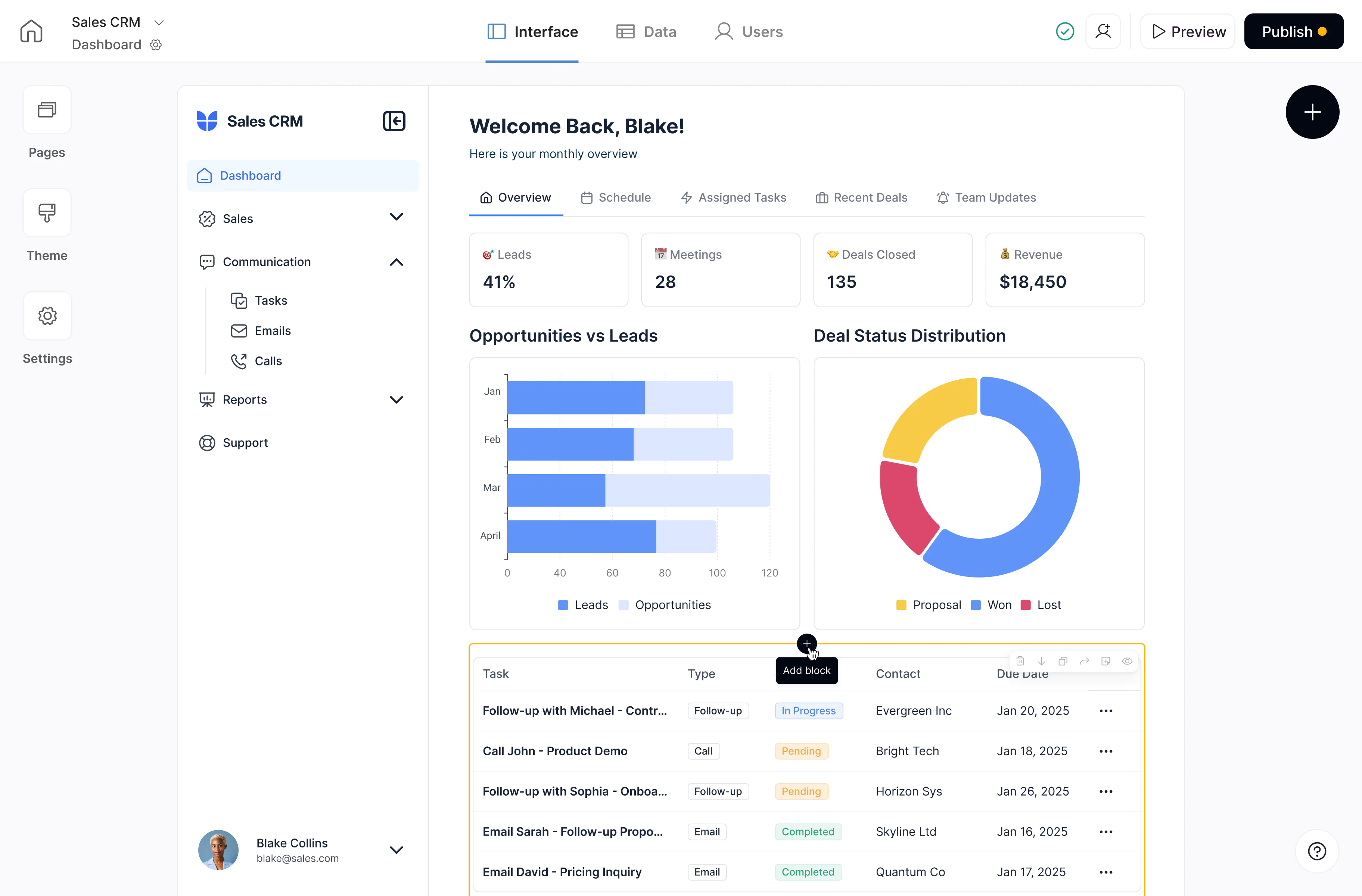
Pros
- Instant setup: Connect Airtable or Sheets and get a working app in minutes.
- Role-based permissions: Granular user access makes it perfect for secure portals.
- Template-rich: Hundreds of pre-built layouts and app types to choose from.
- AI capabilities: Enrich data, summarize text, and automate tasks with built-in AI actions.
- No hosting headaches: Softr handles hosting, security, and scalability automatically.
- Integrations: Connects seamlessly with Stripe, Zapier, Make, and webhooks.
Cons
- Limited database flexibility: You’re tied to Airtable or Google Sheets as your backend.
- Restricted UI customization: Great templates, but less pixel-level control compared to Bubble or FlutterFlow.
- API limitations: Some integrations (like OpenAI or advanced workflows) require higher-tier plans.
- Scalability: Not ideal for apps with very large datasets or custom logic-heavy workflows.
Why it stands out & Best for
Softr stands out because it makes data instantly actionable. Instead of building from scratch, you transform your team’s existing spreadsheet workflows into professional apps and client-facing tools. It’s the perfect solution for operations, HR, or marketing teams who live inside Airtable but want to create beautiful, branded experiences around their data.
Best for:
- Startups and SMBs needing customer or partner portals
- Internal operations teams managing projects, sales, or HR workflows
- Creators and consultants building lightweight SaaS products
- Agencies delivering quick MVPs or data dashboards for clients
Pricing
- Free plan: Build and publish one app with up to 10 signed-in users. Great for testing ideas or internal prototypes.
- Basic ($59/month): Unlocks up to 3 published apps, 20 signed-in users, and additional data records — ideal for small teams or pilot projects.
- Professional ($167/month): Adds API access, advanced integrations, and more record limits. Perfect for apps that rely on dynamic data or automation.
- Business ($323/month): For larger organizations, offering 2,500 signed-in users, all UI blocks, and enterprise-level features.
- Enterprise (Custom): Tailored for large-scale deployments with custom SSO, dedicated support, and white-labeling.
Zapier
Zapier is the automation backbone of the no-code world. The platform that connects your favorite tools and makes them work together automatically. It’s designed to eliminate repetitive manual tasks by linking apps like Slack, Google Sheets, HubSpot, Notion, and over 8,000 others into seamless workflows called Zaps.
The interface is visual and intuitive: choose a trigger (like a new form submission or email), add actions (such as updating a CRM record or sending a message), and Zapier takes care of the rest. Its latest evolution, Zapier Interfaces, lets you go beyond automations — you can now design simple apps, dashboards, and forms connected to your workflows, without writing code.
Zapier has also entered the AI era with AI Actions and AI Agents. You can train chatbots using your own data or set up autonomous agents that take multi-step actions across your systems. For example, an AI agent can analyze customer feedback in Google Sheets, categorize sentiment, update records in Notion, and notify your support team.
It’s the glue that turns disconnected tools into an integrated, intelligent system and for many teams, it’s where their AI journey quietly begins.

Pros
- Massive ecosystem: Connects with over 8,000 apps and services — the largest library in the no-code space.
- Automation-first design: Build workflows that run 24/7 without human input.
- AI integration: Use natural language to create automations or power agents that act on your behalf.
- Ease of use: Clear triggers, actions, and conditions make logic building intuitive.
- Zapier Interfaces + Tables: Create mini apps and data layers directly in the platform.
- Strong documentation and community: Step-by-step guides and ready-made templates.
Cons
- Limited UI control: Great for functional tools, but not for pixel-perfect apps.
- Scaling costs: Pricing grows with the number of tasks (automations run).
- Basic collaboration features: Advanced team management is only available on higher plans.
- Occasional integration lag: Some triggers may not be truly instant depending on the app.
Why it stands out & Best for
Zapier stands out as the connector that powers everything else. It’s not where you’ll build your full app — it’s the automation engine that keeps your stack running in sync. Whether it’s routing leads, updating data, or orchestrating AI agents across your tools, Zapier saves countless hours of manual work every week.
Best for:
- Teams automating repetitive workflows across multiple platforms
- Agencies managing multi-client integrations
- Founders stitching together MVPs or internal dashboards
- Businesses experimenting with AI-powered agents and chatbots
Pricing
- Free: Includes unlimited 2-step Zaps, access to Interfaces and Tables, and up to 100 tasks/month. Great for small projects and personal automation.
- Professional ($29.99/month or $19.99 billed annually): Unlocks multi-step Zaps, premium integrations, filters, and AI fields. Ideal for small teams.
- Team ($103.50/month): Adds collaboration tools, shared folders, and higher task limits. Great for startups and small businesses.
- Company ($748.50/month): Enterprise-grade plan with advanced security, SSO, account control, and live support.
- Add-ons: AI Chatbots and AI Agents are available separately, both with generous free trials and scalable paid tiers.
Make
Make is another powerful visual automation platform that lets you design complex workflows across apps and APIs, all through an elegant drag-and-drop interface. Unlike other no-code automation tools that feel linear, Make gives you a canvas view where you can visualize how data flows between each step, filter, and branch.
Think of it as Zapier for power users. You can connect hundreds of apps, trigger multi-path automations, transform data, and even handle advanced error management — all without writing a line of code. Make excels at giving users control: you can set up routers, loops, and conditional paths that would otherwise require serious coding.
With the rise of AI integrations, Make now supports native connections to OpenAI, Anthropic, and Hugging Face, allowing you to build AI-powered workflows that analyze text, summarize data, or generate content dynamically. Its flexible module system also makes it easy to integrate your internal APIs, so your automations scale as your business grows.
In short: Make gives you the sophistication of developer-level automation in a drag-and-drop experience that anyone can learn.
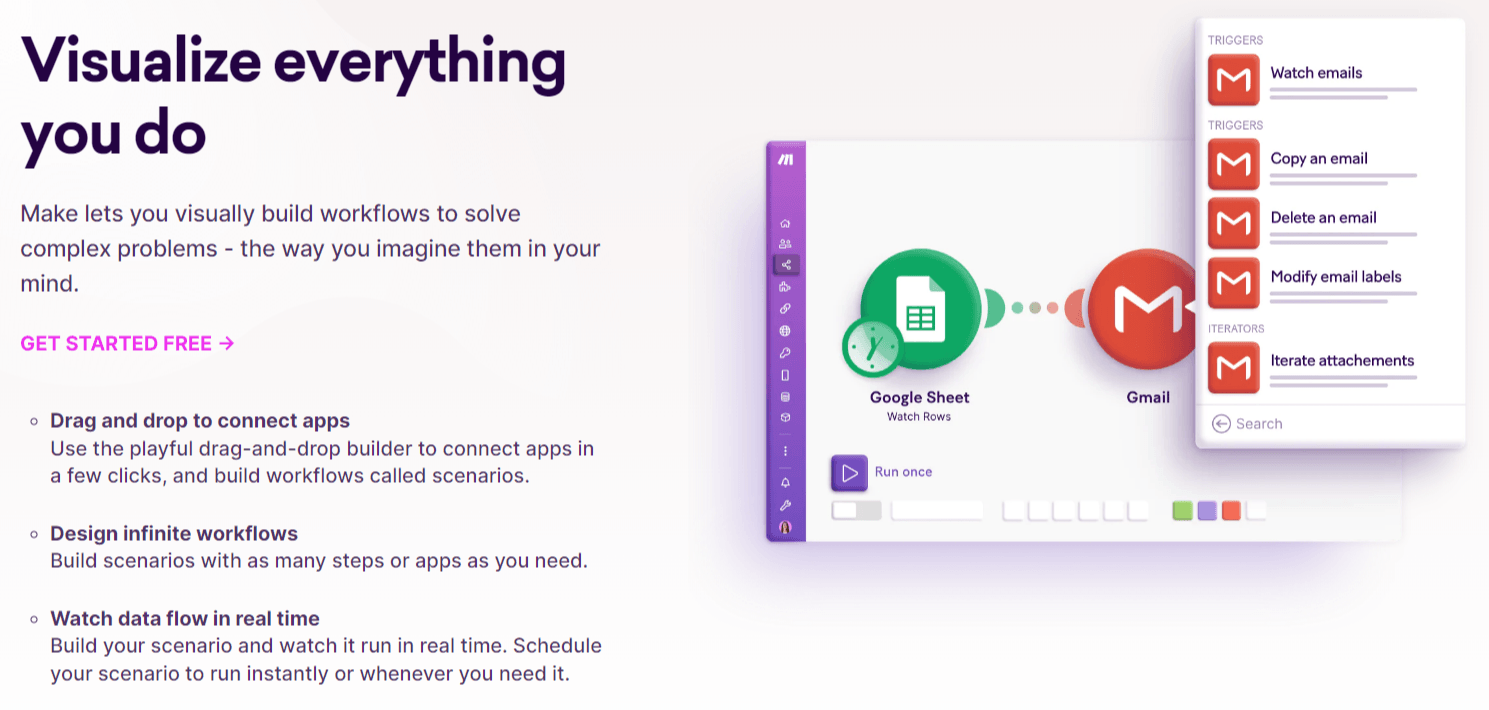
Pros
- Powerful visual builder: The flowchart-style canvas offers unmatched clarity and control.
- Advanced logic support: Includes loops, branching, error handling, and scheduling.
- Deep app ecosystem: Connects to over 1,800 apps and any API with webhooks or custom requests.
- AI-ready: Native OpenAI and Anthropic modules for text generation, classification, and analysis.
- Real-time execution: Watch data move through each step with detailed logs.
- Flexible pricing: Pay based on operations rather than number of Zaps or integrations.
Cons
- Learning curve: The visual editor is powerful but can be intimidating for beginners.
- Debugging complexity: Large scenarios with many branches can become visually crowded.
- Performance limits: Heavy workflows with thousands of operations may need optimization.
- Fewer pre-built templates: Compared to Zapier, more setup time is required initially.
Why it stands out & Best for
Make stands out for one reason — control without code. It’s built for users who want more than plug-and-play automations and are ready to design sophisticated systems that think, branch, and adapt.
It’s particularly strong for ops-heavy teams or tech-savvy marketers who need to sync data across multiple systems, automate reporting, or orchestrate AI workflows with precision.
Best for:
- Operations and marketing teams automating multi-system workflows
- Product managers building complex data pipelines or automations
- Developers and analysts who want deep control without coding
- Agencies managing multiple client automations or integrations
Pricing
- Free plan: Includes 1,000 operations/month and unlimited active scenarios — perfect for small automations and testing.
- Core ($10.59/month billed annually): Adds 10,000 operations/month, real-time execution, and premium app integrations.
- Pro ($18.82/month billed annually): Increases limits to 40,000 operations/month and unlocks higher execution frequency (every minute).
- Teams ($34.12/month billed annually): Adds advanced collaboration, scenario sharing, and team management.
- Enterprise (Custom): For high-volume automations with SLA support, SSO, and dedicated infrastructure.
n8n
n8n is a “fair-code” workflow automation platform that helps you connect your tools, APIs, and data through a visual, node-based builder and no complex coding required. Think of it as a digital flowchart where each node performs an action: reading an email, updating a record, or triggering a message in Slack.
Unlike traditional automation tools, n8n offers open-source transparency with professional support. Its fair-code model lets you view and modify the source code, self-host your instance, and extend it with custom logic, while still benefiting from an actively maintained and feature-rich platform.
You can use n8n to automate anything from customer onboarding to AI-assisted reporting. For example, when a payment is processed in Stripe, it can create a new CRM record, send a welcome email, and post a Slack notification. When a new article goes live on your site, n8n can automatically publish formatted posts to LinkedIn and X, keeping your channels synchronized.
With built-in integrations for OpenAI, Anthropic, and Hugging Face, you can now embed intelligent text generation and data classification directly into workflows. For teams managing sensitive information, n8n also supports on-premise hosting, ensuring full control over data privacy and compliance.
In short, n8n bridges everyday tools with automation that’s powerful, flexible, and transparent by design - a balance rarely found in modern workflow platforms.

Pros
- Open-source and self-hostable: Full data ownership and on-premise deployment options.
- Developer flexibility: Inject JavaScript directly into workflows for advanced logic.
- Custom node creation: Extend functionality with your own integrations or REST APIs.
- AI-ready: Native AI nodes for prompt execution, text analysis, and autonomous workflows.
- Community-driven: Thousands of active users, templates, and tutorials from open-source contributors.
- Hybrid approach: Combine no-code automation with low-code customization in one place.
Cons
- Steeper learning curve: Requires some technical understanding to unlock full potential.
- Setup complexity: Self-hosting needs DevOps familiarity or managed hosting support.
- UI not as polished: Functional but less refined compared to tools like Make or Softr.
- Limited built-in templates: More hands-on configuration compared to plug-and-play alternatives.
Why it stands out & Best for
n8n stands out for its openness and flexibility. It’s the only tool on this list that truly blurs the line between no-code and full-code, allowing you to go beyond simple automations into complete data workflows and AI orchestration — all within your control.
It’s perfect for engineering-minded teams, data analysts, and AI experimenters who want the freedom to customize every detail without relying on a third-party platform. If you’ve ever outgrown Zapier or Make and wished for more autonomy — n8n is where you graduate.
Best for:
- Tech-savvy teams managing sensitive data or compliance-heavy workflows
- Startups and agencies that want to self-host or white-label their automation tools
- Developers bridging AI models, APIs, and internal systems
- Enterprises needing transparency and data ownership in their automation stack
Pricing
- Free (Self-hosted): Fully open-source version with unlimited workflows, executions, and integrations — ideal for teams who want full control.
- Cloud Starter ($20/month): Hosted by n8n with 5,000 monthly executions and access to the visual builder without server management.
- Pro ($50/month): 20,000 monthly executions, custom credentials, and private nodes.
- Team ($120/month): Multi-user access, advanced permissions, and higher limits for growing teams.
- Enterprise (Custom): Includes SSO, dedicated support, on-premise deployments, and custom execution limits.
Relay.app
Relay.app is a modern workflow automation platform built for teams that want to streamline collaboration around recurring work — approvals, reviews, and status updates — without drowning in notifications or manual follow-ups.
Unlike traditional automation tools that run silently in the background, Relay brings humans back into the loop. It combines no-code automations with collaborative task tracking, allowing teams to assign steps, leave comments, and trigger actions directly from the workflow.
Picture it as the middle ground between Asana and Zapier: automation powerful enough to move data between apps like Slack, HubSpot, and Notion, but with built-in human checkpoints for reviews, decisions, and sign-offs.
Relay integrates with major AI providers to summarize messages, generate drafts, or recommend next steps automatically turning repetitive tasks into guided workflows that feel effortless for users and managers alike.
It’s built for clarity and accountability, giving teams a live view of who’s doing what, when, and why. Which is something most automation platforms overlook.

Pros
- Human-in-the-loop design: Combine automated actions with manual reviews or approvals.
- Beautiful and intuitive UI: Modern interface that’s easy for non-technical teams to navigate.
- Collaborative workflows: Assign steps, track ownership, and leave context directly in tasks.
- AI-powered assistance: Generate summaries, next steps, and draft responses using leading AI models.
- Deep integrations: Works seamlessly with Slack, Gmail, HubSpot, Notion, Google Sheets, and more.
- Built-in visibility: Real-time dashboard of progress and blockers across your organization.
Cons
- Smaller ecosystem: Fewer integrations than veteran players like Zapier or Make.
- Limited developer customization: Not ideal for complex API or data-heavy automations.
- Newer to market: Features and connectors are expanding but still catching up in breadth.
Why it stands out & Best for
Relay stands out by re-introducing the human element into automation. Where tools like Zapier and Make excel at background execution, Relay makes automation visible, structured, and collaborative — ideal for teams managing approvals, client reviews, or recurring status workflows.
Its AI-assisted summaries and built-in accountability make it a favorite for operations, marketing, and project management teams that rely on handoffs between people.
Best for:
- Teams that want automation with visibility and shared context
- Managers overseeing multi-step, recurring processes
- Companies balancing structured workflows with flexible collaboration
Pricing
- Free Plan: Automate up to 100 tasks per month with core integrations, manual steps, and Slack notifications. Ideal for testing small team workflows.
- Pro ($15/user/month): Expands to 2,000 monthly runs, priority support, and AI features like summarization and draft generation.
- Business ($30/user/month): Adds advanced permissions, analytics, and multi-team management.
- Enterprise (Custom): Includes SSO, enhanced security, and dedicated onboarding.
Top No Code App Builders For Web And Mobile
Overview of leading app builders
The strongest picks for general‑purpose building remain Airtable for governed, data‑centric apps; Bubble for flexible web apps; Flutterflow and Softr for speedy mobile/web apps and portals; plus Lovable for prompt‑to‑app prototypes that evolve quickly. Many teams ship front‑ends through a no‑code editor and later move to Vercel for production deploys when traffic and polish requirements grow.
Key features and use cases
- Portals and CRMs: Softr on top of Airtable or SQL, with role‑based pages and in‑app AI assistants.
- Internal tools: Flutterflow or Bubble for forms, approvals, and data views with AI steps for summarization or tagging.
- Customer‑facing apps: Bubble for complex logic, then Vercel hosting when you take it public at scale.
- Prompt‑driven prototypes: Lovable to generate a working app from natural language, then iterate via chat.
Leading No Code AI Automation And Agents
Overview of automation platforms
Automation platforms turn individual apps into systems. Zapier’s orchestration, Make’s scenario depth, n8n’s extensibility, and Relay.app’s AI‑centric workflows cover most needs. Inside app platforms, built‑in agents now execute multi‑step tasks on data, within defined boundaries, and log outcomes for review.
How automation accelerates workflows
- Shorter cycle time: Trigger actions when records change. Move information instantly between tools.
- Consistency with review: Use agents to propose actions, then gate with human approval for sensitive steps.
- Operational clarity: Logs and dashboards show what happened, when, and why—a must for AI‑assisted work.
Analytics And Generative AI Tools For Everyone
Overview of analytics and generative AI platforms
No‑code analytics and generative tools let teams ask questions in plain language and package the answers in shareable apps. Examples include Airtable’s AI‑native app platform and automation platforms like Relay.app that orchestrate LLM steps across your stack, plus builders that integrate LLM steps for summaries, extraction, and content generation.
Use cases for teams and individuals
- Self‑serve insights: Create a “chat with data” app for support trends, sales velocity, or marketing lift.
- Content at scale: Spin up structured generators with approval queues, grounded on brand guidelines.
- Predict and prioritize: Churn risk, lead scoring, inventory forecasts—delivered as simple, governed apps.
How To Choose The Right Tool For Your Team
Match goals to categories
- Apps and portals: Airtable, Bubble, Flutterflow, Softr.
- Automation and agents: Zapier, Make, n8n, Relay.app; plus built‑in agents where your data lives.
- Prototypes to production: Lovable for prompt‑to‑app; Vercel when you need global delivery.
- Analytics and AI workflows: Relay.app or app‑native analytics blocks.
Map roles across user, developer, and marketer
- Business owners: Define outcomes, own prompts, and approve outputs.
- Technical partners: Configure integrations, model access, and governance.
- Operations and marketing: Build the app surface, test workflows, and measure results.
Pilot with one project then scale
- Pick a narrow use case → measure baseline: For example, support ticket summarization time.
- Stand up a minimal app → validate fit: Connect a small data slice and ship to a pilot group.
- Add guardrails → expand access: Roles, reviews, and clear data scopes before wider rollout.
- Instrument outcomes → iterate: Track time saved, quality, and edge cases; refine prompts and logic.
Bottom Line
The best no-code AI tools in 2026 share a simple promise.
More people can ship trustworthy apps and agents, faster, with governance built in. Start with a real problem, pick a platform that matches your data and compliance needs, and pilot one project to learn how your team wants to work.
Next step: shortlist two or three tools - Airtable for governed apps and agents, Lovable for prompt‑to‑app speed, and Vercel for production delivery—then run a 30‑day pilot to turn intent into impact.
Ready to move?
Book a call and we’ll help you choose the right stack and stand up your first AI‑powered workflow.
FAQs
What is the best no-code AI tool?
There isn’t a single winner. For governed, data‑centric apps with embedded agents, Airtable stands out. For prompt‑to‑app prototyping, Lovable is compelling. For flexible web apps, Bubble remains strong. For front‑end deployment at scale, many teams ship on Vercel. Choose based on data, governance, and where the app will live.
Why is "no code" becoming popular?
Demand for fast delivery and wider participation in building has grown. Organizations want democratized development, rapid prototyping, and strong UX—all areas where no‑code AI removes friction.
Is Bubble truly no-code?
Yes for most app logic and UI. You can build responsive, data‑driven apps visually, then extend via APIs when you hit advanced needs. Many teams never leave the visual layer, others blend in low‑code for edge cases.
Heading
Dolor enim eu tortor urna sed duis nulla. Aliquam vestibulum, nulla odio nisl vitae. In aliquet pellentesque aenean hac vestibulum turpis mi bibendum diam. Tempor integer aliquam in vitae malesuada fringilla.
Mi tincidunt elit, id quisque ligula ac diam, amet. Vel etiam suspendisse morbi eleifend faucibus eget vestibulum felis. Dictum quis montes, sit sit. Tellus aliquam enim urna, etiam. Mauris posuere vulputate arcu amet, vitae nisi, tellus tincidunt. At feugiat sapien varius id.
Heading 3
Eget quis mi enim, leo lacinia pharetra, semper. Eget in volutpat mollis at volutpat lectus velit, sed auctor. Porttitor fames arcu quis fusce augue enim. Quis at habitant diam at. Suscipit tristique risus, at donec. In turpis vel et quam imperdiet. Ipsum molestie aliquet sodales id est ac volutpat.
Tristique odio senectus nam posuere ornare leo metus, ultricies. Blandit duis ultricies vulputate morbi feugiat cras placerat elit. Aliquam tellus lorem sed ac. Montes, sed mattis pellentesque suscipit accumsan. Cursus viverra aenean magna risus elementum faucibus molestie pellentesque. Arcu ultricies sed mauris vestibulum.
Heading 4
Morbi sed imperdiet in ipsum, adipiscing elit dui lectus. Tellus id scelerisque est ultricies ultricies. Duis est sit sed leo nisl, blandit elit sagittis. Quisque tristique consequat quam sed. Nisl at scelerisque amet nulla purus habitasse.

Heading 5
Morbi sed imperdiet in ipsum, adipiscing elit dui lectus. Tellus id scelerisque est ultricies ultricies. Duis est sit sed leo nisl, blandit elit sagittis. Quisque tristique consequat quam sed. Nisl at scelerisque amet nulla purus habitasse.
"Ipsum sit mattis nulla quam nulla. Gravida id gravida ac enim mauris id. Non pellentesque congue eget consectetur turpis. Sapien, dictum molestie sem tempor. Diam elit, orci, tincidunt aenean tempus."
Heading 6
Nunc sed faucibus bibendum feugiat sed interdum. Ipsum egestas condimentum mi massa. In tincidunt pharetra consectetur sed duis facilisis metus. Etiam egestas in nec sed et. Quis lobortis at sit dictum eget nibh tortor commodo cursus.
What is Singular Innovation
Lorem ipsum dolor sit amet, consectetur adipiscing elit. Suspendisse varius enim in eros elementum tristique.


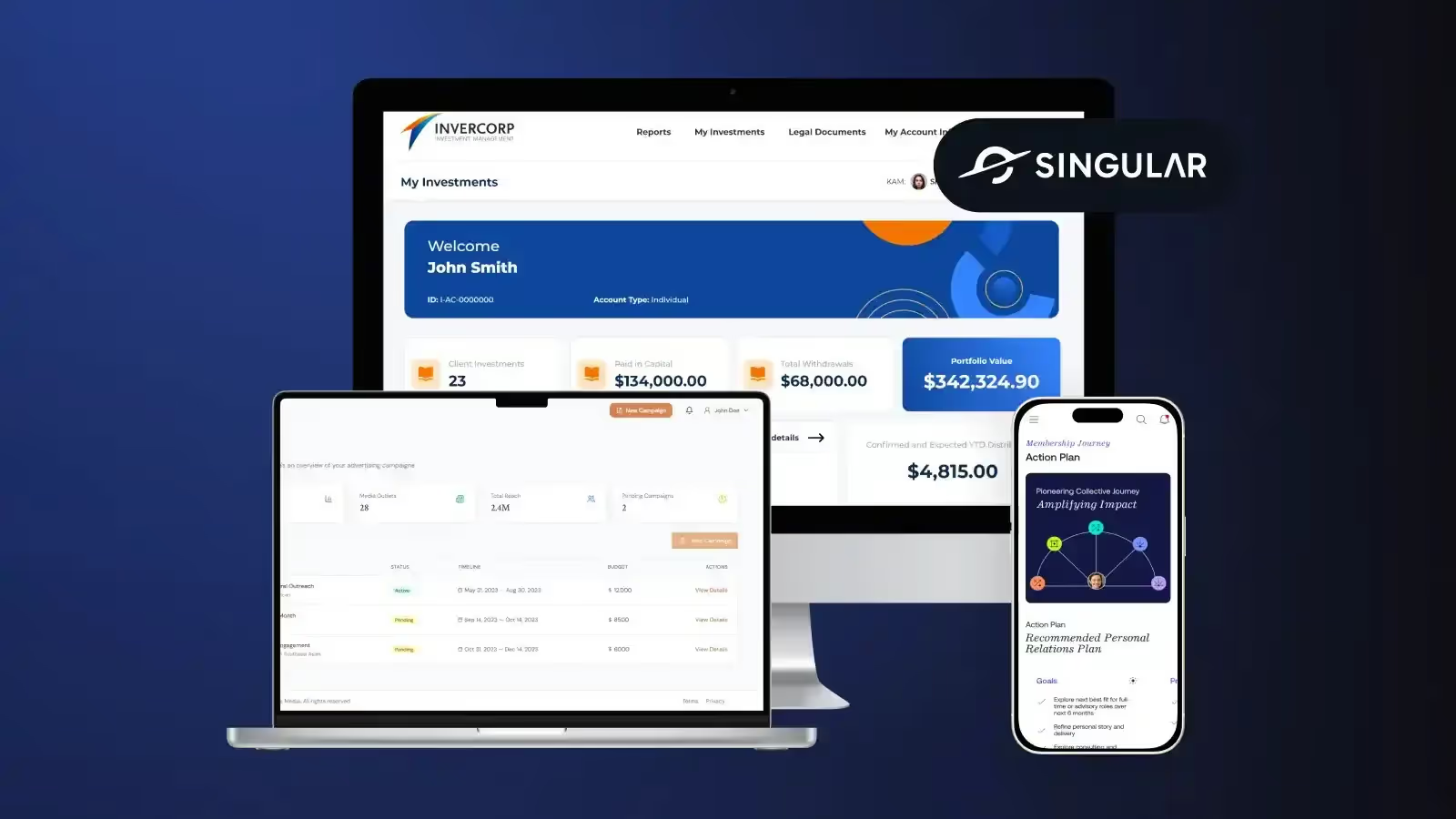
.avif)


